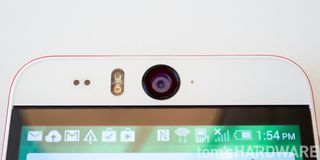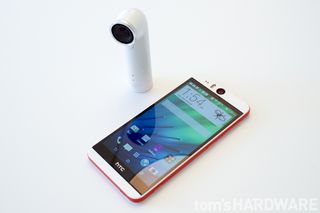HTC Announces Desire EYE Smartphone, RE Camera At NYC Double Exposure Event

In NYC today, HTC made three big announcements at its ‘Double Exposure’ event, where the company claimed that it is "redefining mobile imaging". The first announcement is the new Desire EYE, its new mid-tier flagship phone, with 13 MP cameras on both the front and back.
The second announcement is the RE viewfinder-less hand-held 16 MP camera, and the last announcement is that Zoe, HTC’s video highlights app, is coming to the Play Store now and to iOS later this year.
Peter Chou, HTC’s CEO, took to the stage and proclaimed that the company is creating a "new class of mobile experiences" and that today’s announcements are "reimagining HTC". We also met with HTC prior to the event and got some brief hands-on time with the EYE and RE. Stay tuned for our more in-depth hands-on with video.
HTC Desire EYE

The Desire EYE is the latest handset in HTC’s mid-range desire line. However, unlike previous Desires, the EYE sports some top-end internal hardware, making it comparable in many ways to the One M8 and E8.


The hero feature of this new phone is its front and rear 13 MP cameras, with dual-LED flashes on both. Obviously, HTC is targeting the selfie crowd, though at our meeting, HTC was sure to let us know that they don’t want to emphasize that the EYE is a selfie phone because of the negative "self-obsessed" connotations that the term has. While we weren’t able to find out the exact sensor in the EYE’s camera, we expect that it's the same 13 MP BSI found in many of HTC's other recent handsets. The rear camera is 28 mm wide and has an f/2.0 aperture, and the front camera is a wider 22 mm with an f/2.2 lens. There is also a hardware shutter button (hallelujah!).

In order to leverage the dual cameras, HTC has also upgraded its camera software with new modes and features, what it's calling the HTC EYE Experience. Some of the features that have been added are improved video calling that uses face tracking to keep you in the frame even if you are moving around while talking. There is also a split-capture mode that can simultaneously take stills or videos from both cameras into one image or video. HTC is also adding voice commands to trigger the shutter to help make taking selfies easier. HTC also announced that the new EYE Experience camera features will be coming to other HTC phones, including the ONE M8.

Despite the great camera hardware, the EYE is still a Desire product, so don’t expect to find any metal here. It’s an all-plastic device, but it is an IPX7 waterproof phone, which is a first for HTC.
Stay on the Cutting Edge
Join the experts who read Tom's Hardware for the inside track on enthusiast PC tech news — and have for over 25 years. We'll send breaking news and in-depth reviews of CPUs, GPUs, AI, maker hardware and more straight to your inbox.
As mentioned before, despite it being a mid-tier phone, the Desire EYE does have some high-end specifications, such as being powered by a 2.26 GHz Snapdragon 801 MSM8974AB SoC. It has a 5.2” Full HD IPS display, 2 GB of RAM, 16 GB of internal storage (and a microSD slot) and a 2,400 mAh battery. It also has front facing Boomsound speakers, with the same hardware amplifiers as the One M8. All-in-all, these are some pretty kick-ass specs for a mid-tier device. One compromise (other than the plastic construction) to bring the costs down is that the EYE does not support wireless AC. Still, based on our brief time with it, the EYE is a really nice phone.
The HTC Desire EYE will be an AT&T exclusive in the US, and pricing and availability were not announced at today’s event.
RE Camera
The RE is HTC’s attempt to take on the growing small handheld camera market, although HTC was keen to express that it isn't going after the GoPro category – the RE is not a camera for extreme sports. The example that HTC used is that too often at an important event, be it a concert or a family gathering, you spend more time looking at your phone’s screen while taking pictures and video than actually experiencing the moment, and the RE seeks to address this.

It does not have a viewfinder, but it has a very wide lens, so you can be sure that what you want to capture is in frame without being able to see it. Of course, if you do need to see what you are shooting, you can remote control it with your iOS or Android phone and use that as a viewfinder.
The 16 MP RE turns on when you pick it up thanks to the capacitive sensor in its body, and you tap the button on the back to take a still picture or hold it down to take a Full HD (1080p) video. It is also capable of shooting 80 FPS slow-motion video and taking time-lapse video, too. While the RE doesn't have any livestreaming functionality out of the box, HTC announced that livestreaming with the RE will be coming in the future via a partnership with YouTube.

The RE has an 810 mAh battery and captures 1.5 hours of video or 1200 stills, and there's a microSD slot for image storage. An 8 GB card comes in the box. It will be $199 and come in multiple colors when it goes on sale in the U.S., with availability directly from HTC and leading retailers and carriers, including Best Buy, Amazon and Verizon.
Zoe
The last announcement was HTC’s Zoe video highlight application, which has been available in beta for select Android devices for some time and will be coming to all Android devices in the Play Store now (and to iOS later this year). HTC has also added a new collaboration mode, where you can remix content from other users' Zoe's into yours.
Overall, HTC’s event today was important because it demonstrates that the company is really trying to bring something different to the table than its competitors. The Desire EYE looks to be a solid mid-range device (though it is a pity that it is exclusive to only one carrier in the US), and the RE Camera is certainly a very unique and innovative low-cost imaging device.
Stay tuned for our video hands-on with the Desire EYE.
Follow us @tomshardware, on Facebook and on Google+
-
EasyLover Finally a selfie phone with good specs. Thankfully, HTC does not include ultra pixel cam in this phone. It is a shitty execution of a good idea by HTC.Reply
Most Popular


